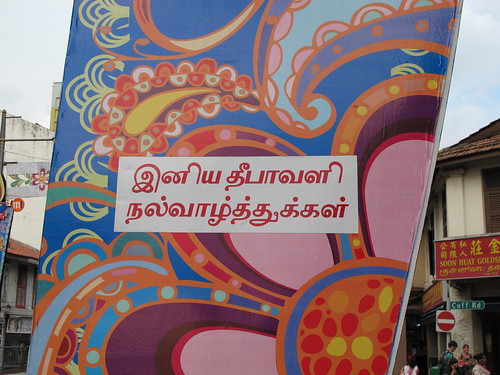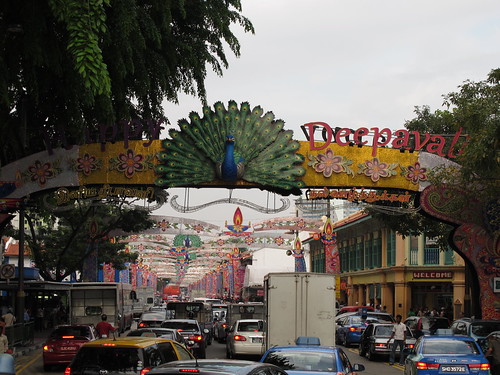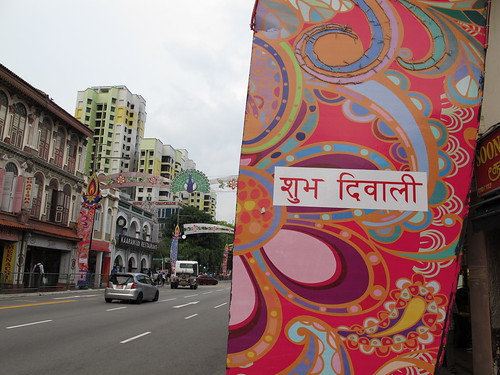To all Hindus, Happy Deepavali / இனிய தீபாவளி நல்வாழ்த்துக்கள் (iniya deepavali nalvazhthukkal). It's a public holiday here in Singapore. Unlike last year when I was really getting into the spirit of the Nepali counterpart Tihar (see here), this year there won't be any such cultural immersion for me. However, I did drop by Little India here in Singapore yesterday looking for sweets, which was a big mistake, given the last minute rush for sweets and other items for pooja / puja.
The majority of Singaporean Indians are Tamil, and the Tamil language is one of the official languages of Singapore, though sadly, it's usually the forgotten child out of the four - the only Tamil I ever paid attention to while growing up in Singapore was vannakkam, which I'd often hear at the end of the Tamil news. Also, there was never any motivation for me to learn Tamil, given that we spoke English at home, I had to learn Mandarin in school and Malay would've been my next choice since my parents speak Malay.
In any case, it's not surprising that you find signs like this one in Tamil (which reads iniya deepavali nalvazhthukkal):

But nowadays, it's also not uncommon to see signs in Hindi as well, like this one which reads: शुभ दिवाली (shubh diwālī).
A note about the etymology of the Hindi diwālī (the use of the macron indicates a long vowel): many websites I've seen say that the Hindi is a 'contraction' of the Sanskrit दीपावली dīpāvalī, a compound of दीपा dīpā 'lamp' and avalī अवली 'row'. I'm certain linguists have already worked out the exact sound changes - I just haven't spent the time doing the research, but I thought I'd have a go at explaining why it's called diwālī in Hindi, but deepavali in Tamil.
First of all, Tamil தீபாவளி deepavali (or more precisely, tīpāvaļi since Tamil does not make a meaningful contrast between the sounds d and t) has clearly preserved the number of syllables of the original word. I'm assuming here that Tamil, probably Middle Tamil, borrowed the term from Sanskrit.
In contrast, if we assume that Hindi दिवाली diwālī is ultimately from Sanskrit दीपावली dīpāvalī, the easiest way to explain the change would be to say that the Hindi form has undergone 'lenition', a common sound change whereby consonants 'weakened' in some way, particularly when they are surrounded by two vowels. We see such lenition in most varieties of English, e.g. the t in words like water and city are rarely pronounced like the t in words like term and tea: instead of a strongly aspirated stop [th], speakers often just produce a very quick tap of the tongue.
One common sound change pathway is: [p] > [b] > [v] > [ʋ] (a sound similar to [w]) > nothing. If you practise making these sounds, you'll notice that all of them involve using the lips, or at least part of the lips. Speakers of Singlish (or if you listen to the video in my previous post) will notice that the word never is often pronounced neh, with no [v] sound in the middle of the word. This is an example of such lenition.
It is therefore not difficult to see how the original [v] sound in a word like dīpāvalī could be completed deleted, while the [p] sound could lenite to [b] and then to [ʋ] (written as 'w' in transliterations of Hindi).


Great post, Amos - I hadn't really thought about it in those terms, but it makes good sense. Hindi seems to drop Sanskrit syllables quite often - another example is varaya:tra -> ba:ra:t 'groom's journey to bride's house (prior to wedding)'. On a related topic, I'm surprised that the 'official' spelling of the festival name is now 'diwali' (Google returns 12 million hits), whereas 'divali', which is closer to the Hindi way of writing it, seems to be far less popular (3.2 million hits). I'm pretty sure that Hindi speakers would say 'diva:li' when asked for the word. They might use an approximant in connected speech, but then a lot of consonants start sounding quite different in connected speech.
ReplyDeleteAlso, Dravidian languages seem to be a lot better at maintaining the form and meaning of Sanskrit loans than Hindi is - e.g. Skt. shabda 'sound', Kan. shabda 'sound', Hin. shabda 'word'.
I suppose one other issue I didn't raise is that not all Hindi words of Indo-Aryan origin are necessarily descended directly from Sanskrit. Instead, they could have come from one of the Prakrit languages which would have diverged from Sanskrit at an earlier date. In contrast, the reason Dravidian languages 'preserve' the meaning of Sanskrit loans better might be because they borrowed them directly from Sanskrit.
ReplyDeleteAlso, I've used 'wa' here to represent the Devanagari व. I think the standard phonetic transcription for this sound uses the labiodental approximant [ʋ] for the consonant sound (basically a [w] without the velar articulation). However, I've also read somewhere that in reality speakers generally just switch between [v] and [w] and [ʋ].